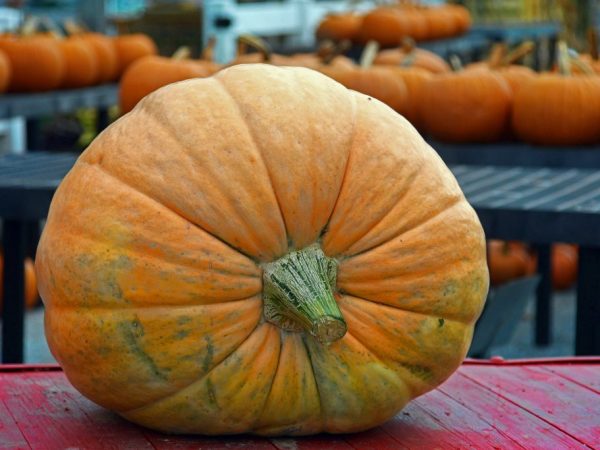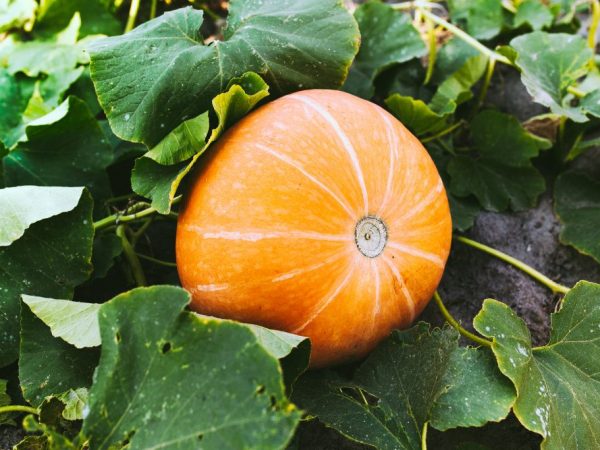Botanical description of pumpkin
Raw pumpkin is used for medicinal purposes, it is often called a casket of vitamins. At the moment, more than 50 varieties have been bred, they differ in appearance, but retain the basic properties and general characteristics of the species.

Botanical description of pumpkin
Description of culture
According to one of the versions, the pumpkin in translation sounds like "plump fruit". It is difficult to think of a more capacious name for this large ribbed dweller.
Origin
Archaeological finds and historical facts claim that the pumpkin was already known 8 thousand years ago. It was grown for the sake of pulp and seeds, and some of the fruits were used to make flasks and bottles for storing drinks and grains.
The vegetable comes from Mexico, the seeds were brought from the Aztecs by the conquistadors. But long before their trip, various manuscripts of the Old World already mention him - this means that the exact origin is unknown.
As a food culture, pumpkin began to be considered in Europe only in the 17th century. Before that, she went only to feed livestock. Its medicinal properties were recognized much earlier, using the juice to treat edema and intestinal disorders, the seeds were used as a powerful anthelmintic. Pumpkin seed oil - as a base for ointments and rubbing.
Botanical characteristic
In determining the type, opinions seriously differ: botanists call it a berry, and gardeners call it a vegetable, since it is definitely not a root crop.
According to the classification, the pumpkin belongs to the annual herbaceous dicotyledonous flowering plants of the pumpkin family. The closest relatives include zucchini and cucumber.
External parameters
On the weaving stems creeping along the ground, large flowers in the form of a bell of a pale yellow or orange color are formed. The leaves are hard-rough, carved.
The culture is subdivided into wild, decorative and dining. There are special forage varieties. The most famous pumpkin is ordinary.
Fruits look different: they can be small or large, round, flattened at the top and bottom, elongated, in the shape of a ball or even a star.
Growing features
Cultivation is grown on an industrial scale, in the country and in the garden. She is not whimsical to the soil, you can get a good harvest on virgin soil. Dislikes the neighborhood of nightshades.
The peculiarity is that the sprouts collect nearby moisture, successfully developing almost without watering.
The cost of seeds ranges from 6 to 25 rubles per 10 g, the price of ripe fruits per season is 10-12 rubles per kg, closer to spring it can grow to 65.
Varieties have been developed with a dense crust that can calmly lie in a cool, dark place until March and remain fit for food.
Nutritional value and composition
The value of the pumpkin is great. It is rich in vitamins C, E, PP, B, A, K. It also contains:
- zinc;
- iron;
- phosphorus;
- magnesium;
- calcium;
- starch;
- ash;
- alimentary fiber;
- thiamine;
- niacin.
At the same time, the calorie content is very low: only 26 kcal per 100 g.
Beneficial features

Delicious dishes are prepared from pumpkin
Pumpkin pulp is often used in popular diets for weight control and weight loss purposes, replacing 1-2 meals a day. It is used to remove toxins and fecal stones from the intestines, bad cholesterol, has a sedative effect due to the presence of folic and pantothenic acid.
Juice and raw pulp helps with:
- chronic fatigue;
- insomnia;
- increased excitability;
- irritability;
- anemia;
- atherosclerosis.
Prevention of cancer, cardiovascular diseases, prevention of early aging, osteoporosis, maintenance of good condition of the skin, nails, hair are considered important qualities for regular use.
In terms of the content of valuable proteins, pumpkin overtook chicken and quail eggs. It has an anti-inflammatory effect, can increase male potency and sexual desire.
Who is contraindicated
Culture does not have minutes, the only thing worth paying attention to is the presence of individual intolerance.
It is not recommended to include it in the diet for peptic ulcer disease, diabetes mellitus, low gastric acidity, during exacerbations of gastrointestinal diseases.
Interesting Facts
- An interesting interpretation is given to this plant in fairy tales and traditions. In Eastern culture, it symbolizes health and longevity, in Western culture, it is endowed with magical properties.
- The pumpkin has become the hallmark of Halloween, opening the gates at night for evil spirits of all stripes. Side dishes and sweet dishes are prepared from it. Many of them are traditional - for example, millet porridge with its pulp on Spas.
- On the territory of Mexico, a grain was found, the age of which was close to 7 thousand years, and in total there are about 800 varieties in the world. Only a quarter is edible.
- Pumpkin seed oil is very useful, but 35 ripe large fruits are needed to get 1 liter.
The pumpkin is so beloved in some countries that annual festivals are held in honor of it, which have a long tradition. For example, in Ludwigsburg there is a competition for the best sculpture carved from it.
There is also a competition between large fruits, where samples of 400, 600 and even 850 kg are shown.
The record holder in weight was the vegetable of the Belgian Matthias Vilemein, when weighing the indicator was recorded at 1190 kg. At the same time, small pumpkins are recognized as the most juicy and tasty.
At the fair, everyone is offered to buy jam, cakes, pies, noodles and even champagne from a giant berry, since the experiments in its production were successful.
How to choose the most delicious
The demand for pumpkin is constant, it is appreciated by nutritionists and people who practice raw food.
Breeders have bred many varieties, they differ in color, shape, size, thickness of the crust and layer of pulp, growing conditions and taste. The most popular are: Muscat, Volzhskaya gray, Gribovskaya winter, Aport, Dieticheskaya.
The choice of fruits should be based on the requirements.
- If you need them to stay until spring, then the preference is given to the hard varieties Zimnyaya, Gribovskaya, Parisskaya Zolotaya.
- To prepare a sweet dessert that is not inferior to purchased cakes, you can take Muscat; to collect a large number of large white seeds, Volzhskaya gray is suitable.
- Orange varieties are believed to be sweeter.
When buying, they look at the appearance and aroma. If dents, spots, abrasions are noticed, there are places that are soft to the touch, then such a fruit is tasteless, and, possibly, already rotted inside.
The peel should be firm, the pattern is uniform, the stalk is dry, when pressed with a fingernail, no traces remain on the surface. When tapped, a ripe pumpkin makes a dull sound.
If you need a tender homogeneous pulp, then small fruits are acquired. To cleanse the body, a fibrous texture is required, it is present in large ones.
Why there is a bitter taste
Normal food grade tastes sweet. But sometimes the fruit is bitter or downright bitter. This can happen if:
- decorative variety;
- after a drought, the plant received less moisture;
- oversupply of fertilizers;
- the pumpkin has deteriorated during storage.
If the appearance of the flesh has not changed, then a little trick will help to remove the bitterness. The pieces are placed in a saucepan or colander and spilled with boiling water.
Often this problem appears in the spring during long-term storage. In this case, the fruit will have to be thrown away.
Pumpkin application
The list of areas of application is quite wide. Pumpkin is amazing in composition and properties, it is considered a dietary product and is popular in cooking.
Many countries have their own recipes for cooking, they eat it boiled, steamed, baked, in the form of desserts and soups, candied fruits, jam, marmalade are prepared from it.
In cosmetology, pumpkin seed oil is given the honorable role of the basis of massage mixtures; it is a component of masks and creams that preserve the elasticity and smoothness of the skin.
In folk medicine, pulp and seeds are used as anti-inflammatory, decongestant, fortifying, wound healing. Can be used as an anthelmintic, especially when family prophylaxis is needed.
When buying a half or 1/4 of a pumpkin, you should immediately use it for food, the shelf life in the refrigerator does not exceed 2 - 3 days. Then it takes on a sour taste and starts to deteriorate.
Helpful hint: how to cut
Large pumpkins are often sold in the market and bazaar. It is impossible to eat such a fruit at a time; you need to cut it up and prepare it for storage.
Wash first. Then cut in half, remove the seeds and the soft fibrous part, they are also not used for waste.
Cut the halves into slices, which are convenient to peel. Chop the remaining pulp into cubes and put in a plastic bag.
Store in the refrigerator on the vegetable shelf for no longer than 2-3 days. Some can be frozen.
The main healing power is in raw pumpkin, so it is often used in vegetable salad. Such a product is suitable for cooking porridge or mashed potatoes, but you will have to cook without preliminary defrosting.
Small fruits do not need to be cut, they are baked whole or stuffed with cereal mixture with fruits.

